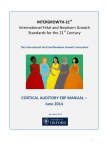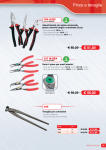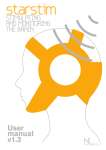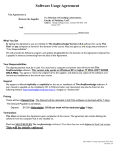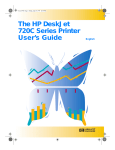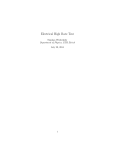Download MRI Kits User Manual Neuroelectrics
Transcript
MRI compatible kits for stimulation with Starstim and Starstim tCS User Manual Table of Contents Introduction.............................................................................................3 Intended Use....................................................................................4 Regulatory Information...................................................................4 Manufacturer.....................................................................................4 Safety Warnings....................................................................................5 I. The MRI Environment........................................................................6 II. Equipment...........................................................................................7 III. Installation....................................................................................... 10 III.1 Bipolar Kit............................................................................... 11 III.2 Multi-channel Kit................................................................... 12 Version: 2.2 Last revision: December 4, 2015 2 Introduction Neuroelectrics provides two kits, bipolar and multi-channel, for stimulation compatible with Magnetic Resonance Imaging (MRI). Both kits are equipped with radiotranslucent components ensuring an artifact-free MRI experience. The MRI kits complement Starstim or Starstim tCS systems. They contain all the additional equipment necessary to conduct stimulation sessions with these two devices during an MRI experiment. The kits work safely for stimulation sessions during up to 3T MRI experiments. The bipolar kit contains a pair of sponge electrodes for stimulation and the compatible electrode cables. It is the ideal solution for cathodal or anodal stimulation sessions. The multi-channel kit takes Starstim (tCS) to the next level. With this kit, all the eight channels of the device can be used for stimulation inside the MRI room. The reduced size of the eight sponge electrodes provided allows multi-focal stimulation experiments and ensures a high spatial resolution of the target area. In addition, two standard sponge electrodes are also part of the kit for eventual bipolar studies. Note that the MRI compatible kits are intended to be used for stimulation. Do not use them for EEG recording. Before using the kit, read the Neuroelectrics User Manual (Starstim, Electrodes and Nic parts). 3 Intended Use The intended use is stimulation during MRI for research purposes. CAUTION: Proper installation of the MRI filter is required. Using the MRI kits without a correct installation of the filter is dangerous. Read pages 10 to 12 to know how to correctly install the equipment. Regulatory Information The MRI kits are intended to be used exclusively for clinical investigation. CAUTION: Investigational device to be used by Qualified Investigators only. Manufacturer The MRI kits are prepared and commercialized by Neuroelectrics. Some of the contents are manufactured by Neuroelectrics. There are a few items, properly identified in this manual, that are originally manufactured by BIOPAC Systems, Inc. Contact Neuroelectrics office for general questions regarding the MRI kit. For questions related to a specific component manufactured by BIOPAC Systems, Inc., we recommend you to contact the original manufacturer. Neuroelectrics Barcelona SLU BIOPAC Systems, Inc. US Corporate Offices Avinguda Tibidabo 47 bis 08035 Barcelona, Spain 43 Aero Camino Goleta CA 93117, USA Telephone: + 34 93 254 03 70 Telephone: +1 805 685 0066 4 Safety Warnings WW WARNING: The installation of the MRI kits is recommended to be handled by personnel specialized in shielding systems. WW WARNING: Place the stimulation electrodes ONLY on the head of the subject. Never place the stimulation electrodes so stimulation currents are permitted to flow through the subject’s heart. WW WARNING: Correct installation of the MRI Filter is required to maintain MRI imaging performance, preserve physiological recording quality, and create a safe operating environment. WW WARNING: Correct installation of the the Patch Panel is required. Radio-frequency (RF) energy generated by MRI can travel through a poorly implemented patch panel and affect the stimulator function. WW The Patch Panel filtering and cabling must have a very low impedance to MRI ground: less than 1Ω at [42*T] MHz, where T is the Tesla strenght of MRI. For a 3T MRI, this means the patch panel should have less than a 1Ω impedance to MRI main ground at 128.1 MHz. WW The Filter must be installed on the Patch Panel in order to be also connected to the MRI ground. WW The electrode cables (leadwires) should run straigth; they should not be coiled or twisted. Furthermore, leads should be insulated from the subject’s skin surface with a towel or a foam pad. WW The MRI compatible kits are intended to be used for stimulation. Do not use them for EEG recording. WW If the user wants to use the device in combination to another device connected to the patient, the user should contact Neuroelectrics to check the correct simultaneous use. WW Phatom testing should be performed, PRIOR to involvement of any human subject. In this situation, an inert object replaces the human in the research study. Additionally, the stimulation leads to object are monitored and recorded during the protocol. In this way, the expected electrical stimulus can be delivered and then VERIFIED, by the monitoring channel, so proper stimulation behavior can be insured. 5 I. The MRI Environment The MRI facilities are always divided in two rooms: the MRI chamber room and the MRI control room. The MRI chamber is the room where the MRI equipment that images the subject is located. This room is shielded against Electromagnetic Interference (EMI). The MRI chamber requires special precautions to enter. No ferrous or similar magnetically influenced materials are allowed inside. The MRI control room is adjacent to the MRI chamber and houses the associated computers and equipment that are used to examine image data or to support the operation of the MRI equipment. Between the chamber and the control rooms, a metal panel establishes the boundary suitable for passing signals between them. The patch panel is typically made of aluminium, and it incorporates a combination of a 9-pin DSUB and BNC connectors. The connectors are inserted in the patch panel for routing electrical signals. MRI Chamber Room P a t c h MRI Control Room P a n e l 6 II. Equipment The MRI compatible kits contain specific equipment that makes possible the use of the stimulation channels inside the MRI room. The contents of the bipolar and multi-channel kits are listed on the table below. Note that the Testboard Cable and the Patch Panel are present, even though they are not included in the MRI kits. Product Bipolar Kit Multi-channel Kit NE047a NE047b NE025MRI Sicktrode MRI 100 100 NE026MRIa Sponstim 25 MRI 2 2 NE026MRIb Sponstim 8 MRI - 8 NE046ab MRI Filter & Harness 1 2 NE046c MRI Electrode Cable 4 10 NE046d MRI Patch Panel - - NE046e MRI Adapter 1 1 NE046f MRI DB9m Cable 1 2 NE039 Testboard Cable - - Code Name 7 MRI Sticktrode NE025MRI The MRI Sticktrode is a disposable and radiotranslucent electrode that can be used as the reference in the MRI chamber. It should be placed on the mastoid and connected to the CMS and DRL channels as described on the Electrode User Manual. This electrode is the model PK-EL508 manufactured by BIOPAC Systems, Inc. MRI Sponstim 25 & 8 NE026MRIa & NE026MRIb The MRI Sponstim is the MRI compatible version of the sponge electrode for stimulation. The MRI Sponstim requires the application of saline solution as described on the Electrode User Manual. Both Bipolar and Multi-channel kits contain two MRI Sponstim 25 with a contact surface of 25 cm2. The Multi-channel kit also includes eight MRI Sponstim 8 with a contact surface of 8 cm2. MRI Filter NE046a The MRI Filter needs to be installed in the patch panel on the control room side. The filter is then connected to the MRI Harness (in the MRI Chamber) and to the DB9m Cable (in the Control Room). This is the MRIRFIF Filter Set systems commercialized by BIOPAC Systems, Inc. It is provided with a Nibbling cutter that can be used to create additional square holes on the patch panel. MRI Harness NE046b The MRI Harness is used inside the MRI Chamber and it connects up to five channels to one MRI Filter located on the opposite of the Patch Panel. This cable corresponds to the model MECMRI-1 manufactured by BIOPAC Systems, Inc. 8 MRI Electrode Cable NE046c The MRI Electrode Cable connects the MRI compatible electrodes to the MRI Harness. It is a 30 cm translucent leadwire. The cable has a snap socket to connect the electrodes at one end, and one touchproof connector compatible with the MRI Harness at the other end. The cable is the model LEAD108C manufactured by BIOPAC Systems, Inc. MRI Patch Panel NE046d The Patch Panel is the metal interface between the MRI Chamber and the Control Room. Commonly, MRI facilities are already equipped with a patch panel which is incorporated in the wall between the chamber and the control room. For that reason the patch panel is not included with the MRI kits. Neuroelectrics may produce a customized patch panel, with slots to insert the MRI Filter(s), upon request. This item is sold separately. MRI Adapter DB9m Cable The MRI Adapter connects up to two DB9m cables to the Starstim (tCS) Necbox. The DB9 male-male cable is used to connect the MRI Filter to the MRI Adapter. NE046e NE046f Testboard Cable NE039 The Testboard Cable connects the MRI Adapter to the Starstim (tCS) Necbox. It is included in the Starstim and Starstim tCS packages, but not in the MRI kits. Nevertheless, this cable is required when Starstim or Starstim tCS are used with the MRI kits. This item can be also sold separately. 9 III. Installation When Starstim or Starstim tCS are used during an MRI experiment, it is essential that all the equipment is correctly installed. The installation of the MRI Kits are recommended to be handled by personnel specialized in shielding systems. The Filter and Patch Panel interface require special attention when installed. Always, make sure that the Patch Panel is properly connected to the ground of the MRI. Harness connector P A T C H P A N E L A metallic L-bracket structure supports the MRI Filter. The L-bracket is attached to the Patch Panel using a pair of screws. Note that two more screws fix the MRI Chamber Room L-bracket to the Filter, but they are already assembled together. The Filter must be placed on the side of the Filter Installation Views Patch Panel that faces the control room, as shown on the diagram. FILTER DB9m cable connector L-bracket Screws to fix the L-bracket MRI Control Room Pages 11 & 12 describe how the bipolar and multichannel montages, respectively, must be assembled. Chamber Room Patch Panel Control Room 10 III.1 Bipolar Kit MRI Chamber Room MRI Sponstim 25 NE046f NE046b 3 4 MRI Filter NE046a 1 MRI Sticktrode Patch Panel NE025MRI 2 2 MRI Adapter NE046e 5 NE039 NE046c 2 1 Testboard Cable MRI Electrode Cable NE026MRIa 1 DB9m Cable MRI Harness CABLE 1 3 2 1 CMS DRL MRI Control Room StarStim Necbox (NE046d) 3 Laptop 4 5 11 III.2 Multi-channel Kit MRI Chamber Room 8 7 6 5 4 NE046c MRI Filter NE046a CABLE 2 MRI Electrode Cable MRI Sponstim 8 3 2 1 CMS DRL 1 2 4 5 DB9m Cable NE046f 1 2 MRI Adapter NE046e 6 Testboard Cable NE039 Laptop MRI Harness NE046b CABLE 1 NE026MRIb MRI Control Room 3 Patch Panel (NE046d) MRI Sticktrode StarStim Necbox NE025MRI 1 2 3 4 5 6 12 Complete now your Starstim and exploit its stimulation capabilites up to the maximum. Brain stimulation and MRI have never been so close. For further information, please contact us at: [email protected] Thank you for trusting Neuroelectrics. MRI Chamber Room













